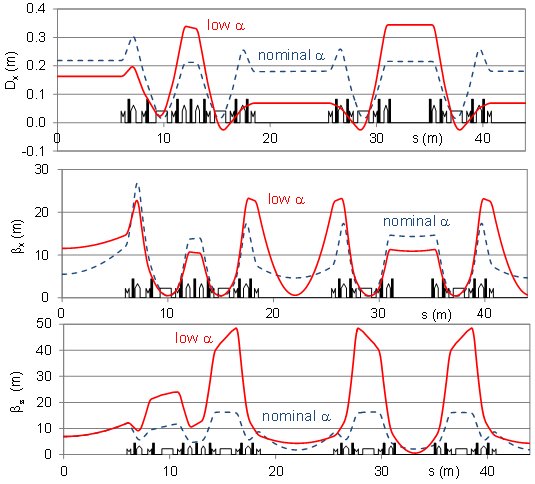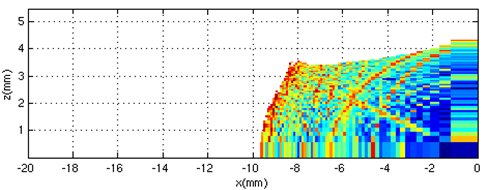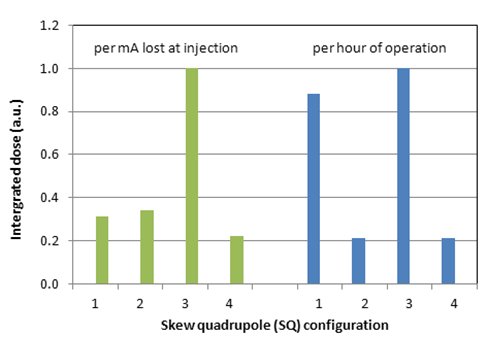Low-Alpha Operation for the SOLEIL Storage Ring
M.-A. Tordeux, J. Barros, A. Bence, P. Brunelle, N. Hubert, M. Labat, A. Nadji, L. Nadolski, P. Lebasque, J.-P. Pollina, Synchrotron SOLEIL, Gif-sur-Yvette, France.
C. Evain, PhLAM, Université Lille 1, Villeneuve d'Ascq, France
Article IPAC12, New orleans, USA, May 2012, pp.1608-1610
Abstract
Low momentum compaction factor (low-alpha) operation has been recently added as a new operation mode at synchrotron SOLEIL. Both time resolved X-ray and THz radiation user communities are taking benefit from a hybrid filling pattern with a 4.8 ps RMS bunch length. With an alpha value of 1.7 10-5 (nominal alpha /25) and a bunch current of 65 µA, stable THz radiation is produced in the range of 8 - 20 cm-1. The optics presented at IPAC’11 [1] has been selected for the operation. This paper gives the comprehensive experimental characterization of this optics. Specificities of the low-alpha operation, driven by the very demanding user experiments, are reviewed: beam position stability, extremely tight injected current increments during Top-up injection, and radiation safety aspects due to beam losses at injection.
Introduction
In the standard SOLEIL Storage Ring 400 mA operation, the electron bunch length is 18 ps RMS for bunches in the multibunch train, and 25 ps RMS for the 5 mA single bunch of the hybrid filling pattern. A new mode of operation which provides electron bunch lengths in the range of a few picoseconds has been optimized, and photon beam has been delivered to users in this mode during two 48 hour sessions in December 2011 and April 2012. The experience gained from the first operation led the users to ask for a Top-up operation. Moreover the transverse coupling has been reduced in order to increase the photon flux reaching the hard X-ray beamline.
The low-alpha mode is intended to satisfy studies in the ps range using THz spectroscopy which highly benefit from the coherent emission, and time-resolved science with X-rays. In the other hand, experiments in the femtosecond range (typically a 100 fs RMS) will be soon possible at SOLEIL thanks to the femtoslicing operation, which is currently under construction.
Low-Alpha Optics
Optical Functions
A low-alpha optics was first calculated and tested in 2009 [2]. A substantial change in the SOLEIL optics compared to the nominal one is made (Fig. 1), which is essentially driven by the control of the first (α1) and second (α2) order of alpha relative to the electron energy deviation, and by keeping the horizontal emittance as small as possible. Eventually, the careful control of the horizontal dispersion function in the dipoles and sextupoles is the key component. This requires the polarity of one of the quadrupole and one of the sextupole families to be inverted. The control of the chromaticity also forces to enlarge the vertical betatron function to compensate for the low horizontal dispersion value in the defocusing sextupoles.
Dynamic Apertures
As a noteworthy consequence of the optics change, degraded performances with respect to the nominal optics are expected in terms of injection efficiency rate and beam lifetime. As the injected beam position amplitude ranges around -9 mm, the on-momentum dynamic aperture stays at the limit (Fig. 2). Moreover, the rotation of the beam in the longitudinal phase space during the injection process makes the off-momentum transverse acceptance especially critical. The one sigma injected beam from the Booster (σL = 28 mm) requires after a ¼ of a synchrotron period a +2.4 % energy acceptance. Figure 3 shows the inadequate off-momentum transverse dynamic aperture, which leads to a measured injection rate of 20 to 25 %.

Figure 1: Optical functions for the nominal alpha optics (dashed blue) and for the low-alpha optics (solid line red). Half a super-period of the ring is displayed (BETA code)

Figure 2: On-momentum dynamic aperture calculated at the injection point for the low-alpha optics (TRACY III code)

Figure 3: Off-momentum 4D-dynamic aperture calculated at the injection point for low-alpha optics (TRACY-III)
Operation parameters
The operation was performed at α1=1.7 10-5 (nominal alpha/25) and a radio-frequency (RF) voltage of 3.2 MV. These settings have been optimized on the basis of the coherent THz spectrum observed on the AILES Infra-Red (IR) beamline [3]. The 2nd and 3rd order of alpha are measured respectively as (1.4 +/- 0.4) 10-4 and (6.9 +/- 0.5) 10-2. Table 1 displays the comparison of the nominal alpha and the low-alpha operation parameters. The RMS bunch length measured with the streak camera was 4.8 +/- 0.1 ps, for a bunch current of 65 µA (77 pC) not far from the micro-bunching instability threshold. This length is significantly higher than the theoretical value at zero current (3.0 ps RMS). Comparison of the measured total beam lifetime of 10 h with simulations (TRACY-III) confirmes this lengthening. Nonetheless, observed longitudinal instabilities remained below +/- 0.1 ps RMS.
| Parameters | Nominal Alpha | Low-Alpha |
|---|---|---|
|
εx (nm.rad) Controlled coupling |
4.0 10-9 0.001 |
8.1 10-9 0.005 |
| Tunes Vx, Vz | 18.18, 10.23 | 20.39, 8.29 |
| Chromaticities ξx, ξz | 1.4, 2.3 | 4, 2.5 |
|
Bunch current Ibunch (mA) x number of bunches |
1.36 x 312 + 5 x 1 | 0.065 x 312 + 0.065 x 1 |
| Lifetime (h) | 18 | 10 |
| Injection efficiency total (%) | 95 | 20 |
| RF voltage (MV) | 2.9 | 3.2 |
| Average pressure (mbar) | 6.5 10-10 | 3.5 10-10 |
In order to satisfy both THz and X-rays communities, the total current (18 mA) was stored in 312 bunches in addition to a single bunch in the middle of the empty quarter (hybrid pattern). A compromise has been found for the transverse coupling so as to lower the Top-up injection frequency on one hand (see below), and to minimize the vertical beam divergence for the hard X-ray beamline on the other hand.
Top-Up Injection
Radiation Safety Issue
The top-up injection with the beamline shutters open is one issue of particular concern in low-alpha mode. It has been demonstrated that beam losses at injection are due to the 4th order coupled resonance 3νx+νz=69 and take place in the vertical plane. So beam losses occur in the in-vacuum undulators when closed at their minimum 5.5 mm magnetic gap. As a consequence, when the skew quadrupoles (SQ) are turn-off (0.5 % natural coupling), the integrated dose measured by beam loss monitors, located dowstream an in-vacuum undulator, is higher by a factor 5 than the measured value for the nominal alpha lattice (Fig. 4). Then, to supress the effect of this resonance, the 32 skew quadrupoles have been used to remove the betatron coupling. Unfortunately, with the resulting coupling of 0.06 %, injection occured every 6 mn, which is incompatible with the scan time of the interferometer of the IR-beamline. As a trade-off 0.5 % coupling was restored using the skew quadrupoles by means of a vertical dispersion wave. The integrated dose per hour of operation was finally found equivalent to that of the nominal alpha operation.

Figure 4: Integrated dose at injection, at an in-vacuum undulator location, for different SQ configurations in the low-alpha mode: (1) betatron coupling is removed, (2) betatron coupling is removed and 0.5 % coupling is restored by means of a vertical dispersion wave, (3) SQ are off, (4) nominal alpha operation.
Injection Process
The beam current per bunch strongly impacts the THz spectrum stability in terms of amplitude and shape, via the electron bunch length and profile. Therefore, the current variation at each refilling was limited to 3 µA per bunch, thanks to special Linac/Booster injector settings. As the injection occurred every 30 min, the injection process has been fully automated by the operation group and special care has been taken to maintain an identical current in all bunches.
Stability Issues
According to the fact that the smaller alpha, the larger becomes the transfer of energy oscillations in the horizontal plane, the transverse beam position stability is in principle strongly affected by the low-alpha optics. Thanks to the two (slow and fast) orbit feedback systems, the stability at radiation source points was maintained at a satisfying level of 10 µm (horizontal) and 0.7 µm (vertical) for the 0.01 to 500 Hz frequency range (Fig. 5). Long term stability remained below a few microns (horizontal) and one µm (vertical) level. Except an optimization of the fast orbit feedback gains, the principle of the correction was unchanged compared to the one used in nominal alpha operation [4], in terms of interaction between fast and low feedback systems and of granularity of RF frequency correction (0.3 Hz).
Despite these good results, discrete jumps of a few microns in the horizontal positions have been observed during the last two day operation. It is equivalent to a RF frequency shift of 0.1 Hz, and remains to be investigated, even if no impact has been seen on the beamlines.

Figure 5: Power spectral density (top) and integrated noise (bottom) with and without the fast orbit feedback system, for α1=1.7 10-5
Conclusion and future
Comparison between measurements of the Coherent Synchrotron Radiation (CSR) and modelling has been done, and reported elsewhere [5-6]. The gain in coherent THz flux compared to the nominal alpha operation (incoherent light) was as high as 104 to 105 in the range of 10 to
20 cm-1. On the AILES beamline, CSR has been used for the first time as a source for spectroscopy of gaseous species at high resolution. For this technique, a high stability of the photon beam is a prerequisite [7]. On Figure 6, the low frequency cutoff of CSR at 8 cm-1 is due to the beamline optics. The high frequency cutoff around 30 cm-1 is a choice related to the alpha value. Indeed tests with smaller alpha values and higher cutoff exhibited a deteriorated stability.
In addition, two X-ray beamlines have taken the beam. At the soft X-ray beamline TEMPO [3], fs laser induced ultrafast demagnetization processes have been inves-tigated by time-resolved resonant magnetic small angle soft X-ray scattering at the Co L3 edge. The overall temporal resolution of ~5 ps RMS is in agreement with the electron bunch length measurement, indicating the absence of any significant jitter and drifts. At CRISTAL beamline [3], the number of photons per X-ray pulse can be estimated to 890 ph/pulse at 10 keV, which is still enough to perform time-resolved measurements on Bragg peaks at the 1 kHz repetition rate (effective flux: 8.9 105 ph/s). In this respect, the foreseen slicing mode sounds very promising, with 40 photons per X-ray pulse at a repetition rate of 2 kHz (effective flux: 8.0 104 ph/s).
As a conclusion, the low-alpha operation has been successfully optimized and maintained during 2 x 2 days. Before the next user operation foreseen in November 2012, other investigation of the low-alpha mode will concern the investigation of beam position noise sources, the negative alpha optics, the optimized filling pattern for THz emission, and further reduction of the bunch length.

Figure 6: Fourier transform THz spectrum for nominal alpha mode with 1mA x 416 bunches (dashed red) and low-alpha mode with 65µA x 416 bunches (solid line blue) measured on the AILES infra-red beamline
Acknowledgement
We would like to thank warmly the operation team as well as the power supply and the diagnostics groups for their continuous and constant efforts, and finally M. Klein for alpha computation from measurements.
References
[1] P. Brunelle et al., IPAC’11, pp 2124-2126
[2] M. Attal, PhD Thesis, Paris-Sud XI University, June 2009
[3] http://www.synchrotron-soleil.fr/Recherche/Lignes
Lumiere/AILES, TEMPO, CRISTAL
[4] N. Hubert et al., DIPAC’09, pp 27-31
[5] E. Roussel et al., this conference
[6] C. Evain et al., EuroPhysics Letters, 2012
[7] J. Barros et al., “Optimizing Coherent Synchrotron Radiation for Broadband Terahertz Spectroscopy”, submitted.
